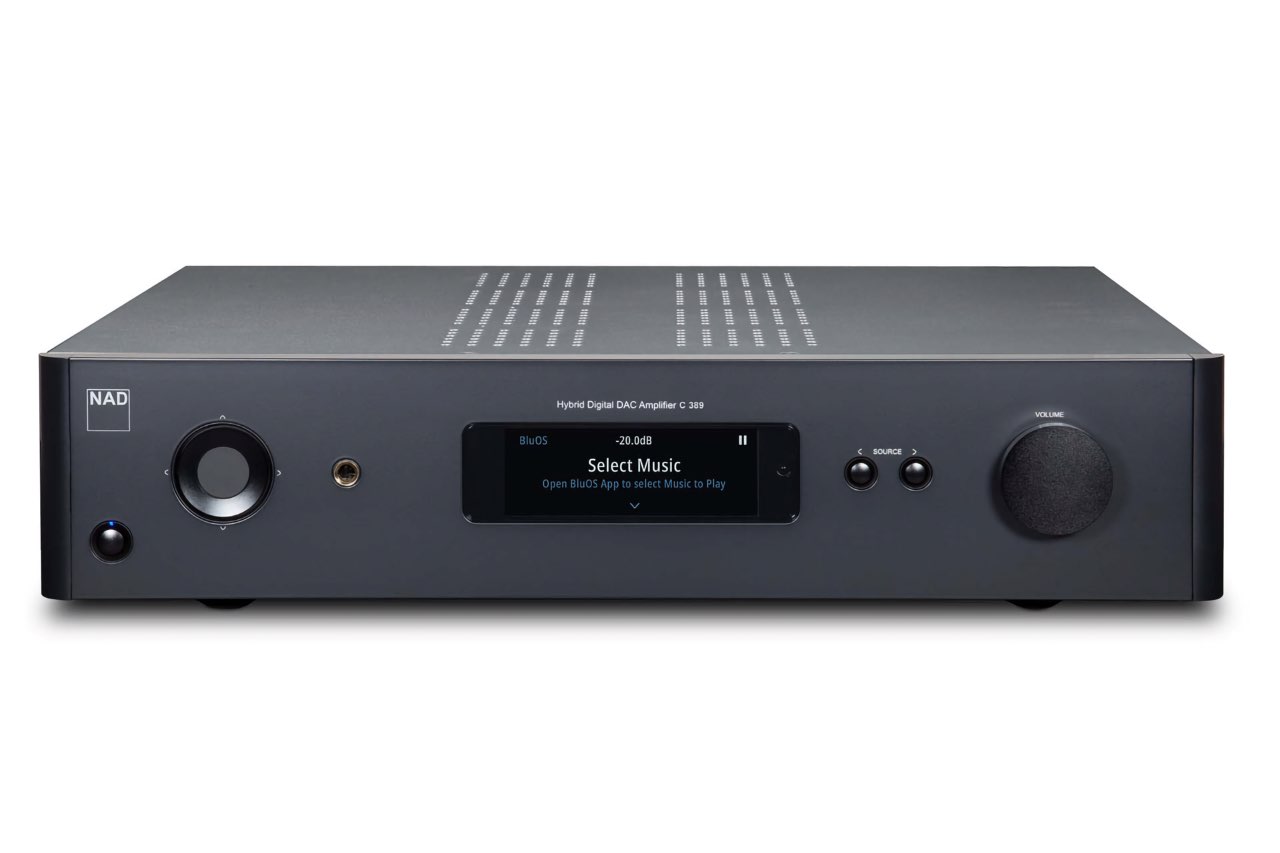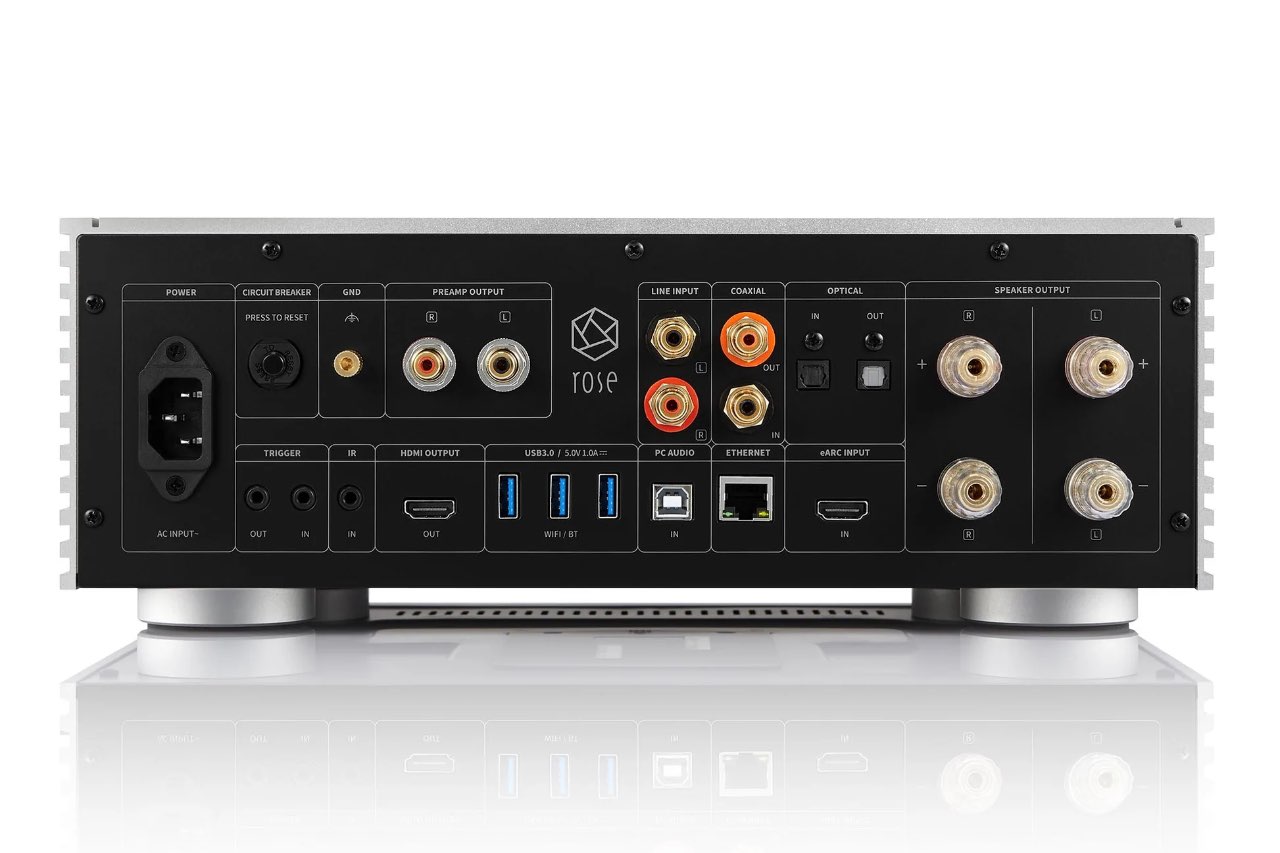Today, music is rarely heard via CD, FM radio, or, heaven forbid, cassette and 8-track — standard bearers of a bygone era. Streaming has ushered in a new wave of trendsetters serving up music using “streaming amplifiers.”
What sets streaming amplifiers apart from more complicated gear is simplicity; just add speakers, and voilà. No wonder this tech is catching on. Besides easy setup, streaming amplifiers offer several key advantages over run-of-the-mill audio equipment.
Streaming amplifiers combine a network player, DAC (digital-to-analog converter), and amplifier in one device. These units feature Wi-Fi and Ethernet, which lets users listen to music from such cloud-based online services as Amazon Music, Apple Music, Qobuz, Spotify, and Tidal (with MQA support for hi-res Tidal Masters). Streaming amplifiers also offer superior sound quality due to their ability to stream lossless audio files, offered by Apple Music for instance.
Many of these devices also support Apple AirPlay 2, Google Chromecast, and aptX Bluetooth to wirelessly receive Bluetooth files for playback and also send whatever is playing to Bluetooth headphones or speakers using Qualcomm’s aptX-HD codec. These features offer greater listening convenience and flexibility. Finally, streaming amplifiers can easily integrate into existing home entertainment systems without bulky equipment that takes up precious space.
One of the primary benefits associated with streaming amplifier technology is its accessibility; users can select their favorite tunes using apps on smartphones and tablets for maximum convenience, all part of the wireless entertainment trend.
Finally, some models support voice assistants, like Alexa and Google Assistant, so listeners can control playback via voice commands rather than using a remote control or fiddling with buttons.
We scoured the internet to find some of the latest cutting-edge equipment. Topping our list in features, including the largest LCD screen at 13 inches, is the HiFi Rose RS520, a $3,600 streaming amplifier (pictured in lead image), from a new brand hailing from South Korea.
Canada-based NAD has launched the C 389 HybridDigital DAC Amplifier ($1,500), which accommodates expansion modules to make it relatively future-proof. The latest in a series of expansion modules is the MDC2 BluOS-D ($550), which adds BluOS high-res multi-room streaming and Dirac Live room correction, widely considered the best room tuning system, to the C 389. NAD also offers the BluOS Streaming Amplifier C 700 ($1,500), which boasts a larger five-inch display but lacks expansion slots and Dirac Live.
 The NAD C 389 ($1,500) boasts an innovation we wish more manufacturers would adopt — the ability to accept expansion modules that add new capabilities. Equipped with the MDC2 BluOS-D ($550), the C 389 adds BluOS high-res multi-room streaming and Dirac Live room correction, features not found anywhere near its price point.
The NAD C 389 ($1,500) boasts an innovation we wish more manufacturers would adopt — the ability to accept expansion modules that add new capabilities. Equipped with the MDC2 BluOS-D ($550), the C 389 adds BluOS high-res multi-room streaming and Dirac Live room correction, features not found anywhere near its price point.
Another Canadian stalwart is Blusound, a sister company of NAD, which manufactures the Blusound POWERNODE EDGE ($650) and POWERNODE ($950). Not surprisingly, both Blusound streaming amplifiers use the highly regarded BluOS Controller app.
U.K. audio companies have become particularly adept at designing streaming amplifiers, putting the Far East to shame. The Naim Uniti Atom ($3,800) was one of the first to arrive on the scene, launched in 2018. Ditto for the Cambridge Audio EVO 150 ($3,250), which debuted in May 2021.
What sets these streaming amplifiers apart is that they all feature an innovative eARC or ARC HDMI input allowing your TV set to turn the device on or off and control volume.
 The rear panel of the HiFi Rose RS520 is far less cluttered than typical AV receivers (AVRs). Shown towards the lower right is the HDMI eARC input. Towards the upper left are the preamp outputs that can be used to connect a subwoofer. The RS520 also boasts three USB inputs designed for thumb drives and connecting networked attached server (NAS) drives.
The rear panel of the HiFi Rose RS520 is far less cluttered than typical AV receivers (AVRs). Shown towards the lower right is the HDMI eARC input. Towards the upper left are the preamp outputs that can be used to connect a subwoofer. The RS520 also boasts three USB inputs designed for thumb drives and connecting networked attached server (NAS) drives.
All streaming amplifiers discussed here can also be hooked up to a powered subwoofer, which, together with HDMI, allows users to set up a 2.1 home theater system. Given that 98% of TV viewers use three speakers or less, that’s welcome news for many.
Have your heart set on a true AVR? The Arcam AVR11 ($3,050), another British make, deserves kudos for boasting one of the most complete feature sets, including 7.1 amplification, MQA decoding (used in Tidal’s highest quality audio streaming) and Dirac Live.
The models listed in the table below all support major streaming services except for Marantz Model 40n ($2,500), which lacks Qobuz functionality, and the Sonos AMP ($700), which supports Amazon Music, Apple Music, and Qobuz:
Streaming Amplifier Comparison
| Description | Alexa Support | Amazon Rating | AirPlay 2 | Amplification | aptX HD | Control app | DAC | Dirac Live | Ether-net | HDMI | LCD Display | MQA | Phono Input | Subwoofer output* | Wi-Fi | WPC** | Price | Size | Weight |
| Bluesound POWERNODE | Yes | 4.2/93 rtgs. | Yes | Class D | Yes | BluOS Controller | TI PCM 5242 | No | Yes | eARC | No | Yes | No | Yes | Yes | 80 | $950 | 8.66"w x 2.76"h x 7.48"d | 7 lbs. |
| Bluesound POWERNODE EDGE | Yes | 3.7/7 rtgs. | Yes | Class D | Yes | BluOS Controller | TI PCM 5242 | No | Yes | eARC | No | Yes | No | Yes | Yes | 40 | $650 | 7.6"w x 1.8"h x 8.7"d | 3 lbs. |
| Cambridge Audio EVO 150 | No | 3.0/2 rtgs. | Yes | Class D | Yes | StreamMagic | ESS Sabre ES9016K2M | No | Yes | ARC | 6.8" | Yes | Yes | Yes | Yes | 75 | $3,250 | 12.5"w x 3-1/2"h x 13-7/8"d | 12 lbs. |
| HiFi Rose RS520 | No | — | Yes | Class AD | Via dongle | RoseConnect | ESS SABRE ES9038PRO | No | Yes | eARC | 12.6" TFT | Yes | Line In | Pre Out | Via dongle | 250 | $3,700 | 13-5/8"w x 5"h x 14-15/16"d | 18 lbs. |
| Marantz Model 40n | Yes | 4.9/9 rtgs. | Yes | Class AB | No | HEOS | ESS Sabre ES9016K2M | No | Yes | ARC | ~2" | No | Yes | Yes | Yes | 70 | $2,500 | 17.5"w x 5-1/8"h x 15-1/8"d | 37 lbs. |
| NAD C 389 | Yes | — | Yes | Class D | Yes | BluOS Controller | ESS Sabre 9028 | Yes*** | Yes | eARC | ~3" | Yes*** | Yes | Yes (2) | Yes | 130 | $2,050 | N.A. | N.A. |
| Naim Uniti Atom | Google Asst. | 3.9/19 rtgs. | Yes | Class AB | Yes | Naim | TI PCM-1791A | No | Yes | ARC | 5" | No | Line In | Pre Out | Yes | 40 | $3,800 | 9.625"w x 3.75"h x 10.1875"d | 15 lbs. |
| Sonos AMP | Yes | 4.8/774 rtgs. | Yes | Class D | No | Sonos | N.A. | No | Yes (2) | ARC | No | No | Line In | Yes | Yes | 125 | $700 | 6.36"h x 4.69"w x 4.69"d | 5 lbs. |
| *Subwoofer or preamp out. ** Watts per channel; both channels driven at 8 ohms. ***With optional $550 MDC2 BluOS-D module included in price here. |
If you want to dip your toe into the streaming waters but don’t want to spend much, look no further than the WiiM Mini ($90). This tiny hi-res audio streaming accessory easily connects to your existing stereo and can be controlled by your Spotify Connect or Tidal Connect apps. The company also offers its own user-friendly WiiM Home app that interfaces will all major players.
 The WiiM Mini ($90) is a highly rated audio streamer on Amazon (4.5 stars based on 1,076 ratings) and a great way to immerse oneself in the world of hi-res streaming. WiiM regularly updates its firmware with new features and its WiiM Home app is considered superior to many OEM apps.
The WiiM Mini ($90) is a highly rated audio streamer on Amazon (4.5 stars based on 1,076 ratings) and a great way to immerse oneself in the world of hi-res streaming. WiiM regularly updates its firmware with new features and its WiiM Home app is considered superior to many OEM apps.
Given these leading-edge features, more people will be choosing streaming amplifiers in the near future over conventional stereo components. Not only do they offer superior sound quality but also unbeatable ease of use which makes them ideal for modern-day listeners looking for the ultimate in musical, and video, freedom and flexibility.
